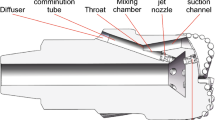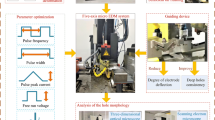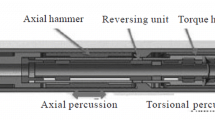Abstract
In horizontal drilling, the cuttings bed is frequently formed to result in severe problems such as backing pressure, binding of bottom hole assembly (BHA) and even sticking of tool. Practice and research show that the smaller particle size is, the more favorable to carry out from bottom of hole in extended reach well or horizontal well. This paper presented a new solution to enhance cuttings transport in mining drilling through a new type of bit called pulsed mill bit (PMB) by using pulse jet mill technique. It provides a promising solution to enhance the efficiencies of rock breaking and cuttings carrying for pulsed jet, sucking cuttings to decrease the chip hold down effect, and reducing cuttings’ diameter to eliminate cuttings bed. The design was supported by the calculation models of Helmholtz resonator natural frequency, optimal drilling fluid flow rate of resonator, drilling fluid flow velocity in forward jet channel, critical impact velocity of cuttings and minimum length of the accelerating cavity. Meanwhile, factors affecting optimal drilling fluid flow rate, critical impact velocity of cuttings and minimum length of accelerating cavity were investigated. Case study showed a good consistency between the calculation results and the related theories. It is concluded that optimal drilling fluid flow rate increases with the increase of inlet and outlet cavity’s diameter, and decreases with the increase of the diameter of the resonant cavity. Critical impact velocity of cuttings increases with the energy conversion factor (β) and ROP, while decreasing with the final size of the cuttings (dt). This effect is obvious when β<0.2, ROP <3.048 m h−1 and dt<0.3 mm. Minimum length of the accelerating cavity decreases with the increase of the resonator’s natural frequency and separation coefficient (α) of drilling fluid flow rate. This study provides a promising solution to remove cuttings bed in horizontal well.
Similar content being viewed by others
References
Ramadan A, Skalle P, Johansen S T, et al. Mechanistic model for cuttings removal from solid bed in inclined channels. J Pet Sci Eng, 2001, 30: 129–141
Walker S, Li J. The effects of particle size, fluid rheology, and pipe eccentricity on cuttings transport. In: SPE/ICoTA Coiled Tubing Roundtable. Society of Petroleum Engineers. Houston, 2000
Elliott D, Montilva J, Francis P, et al. Managed pressure drilling erases the lines. Oilfield Rev, 2011, 23: 14–23
Song X, Wang Z, Xu X, et al. Danger of cuttings bed in borehole annulus and solution (in Chinese). Oil Forum, 2012, 31: 40–42
Zheng Q, Wang C Y. Cutting bed formation mechanism and the influence on the ECD. Value Eng, 2012, 31: 29–30
Martins A L, Santana M L, Campos W, et al. Evaluating the transport of solids generated by shale instabilities in ERW drilling. SPE Drill Completion, 1999, 14: 254–259
Yan T, Wang K, Sun X, et al. State-of-the-art cuttings transport with aerated liquid and foam in complex structure wells. Renew Sustain Energy Rev, 2014, 37: 560–568
Liu X, Zhen X, Ding G. The model of cuttings bed thickness in highly deviated well. J Univ Petrol China, 1991, 15: 28–35
Duan M, Miska S Z, Yu M, et al. Critical conditions for effective sandsized solids transport in horizontal and high-angle wells. SPE Drill Completion, 2009, 24: 229–238
Larsen T I, Pilehvari A A, Azar J J. Development of a new cuttingstransport model for high-angle wellbores including horizontal wells. SPE Drill Completion, 1997, 12: 129–136
Cayeux E, Mesagan T, Tanripada S, et al. Real-time evaluation of hole-cleaning conditions with a transient cuttings-transport model. SPE Drill Completion, 2014, 29: 05–21
Tomren P H, Iyoho A W, Azar J J. Experimental study of cuttings transport in directional wells. SPE Drill Eng, 1986, 1: 43–56
Ford J T, Peden J M, Oyeneyin M B, et al. Experimental investigation of drilled cuttings transport in inclined boreholes. In: SPE Annual Technical Conference and Exhibition. Society of Petroleum Engineers. New Orleans, 1990
Zhang H, Ren Z, Dong M. Methods to solve cuttings bed in highinclination, long-reached well. Petrol Drill Tech, 1999, 27: 6–8
Dang K, Wang Z, Jian Z, et al. Analysis of cuttings bed control technology in horizontal well. Drill Product Tech, 2011, 34: 25–27
Lockett T J, Richardson S M, Worraker W J. The importance of rotation effects for efficient cuttings removal during drilling. In: SPE/IADC Drilling Conference. Society of Petroleum Engineers. Amsterdam, 1993
Tang C, Hu D, Pei J. Experimental study on the frequency characteristic of the self-excited oscillation pulsed nozzle. Acta Petrol Sin, 2007, 28: 122–125
Wang X M, Wang L Q, Jiao L. Energy loss analysis of the self-excited oscillation pulsed jet with parameters’ change. J Eng Thermophys, 2008, 29: 780–782
Kolle J J. Increasing drilling rate in deep boreholes by impulsive depressurization. In: 4th North American Rock Mechanics Symposium. American Rock Mechanics Association. Washington DC. 2000
Kela L. Resonant frequency of an adjustable Helmholtz resonator in a hydraulic system. Arch Appl Mech, 2009, 79: 1115–1125
Ru D, Liao R, Xiong J, et al. Study of frequency character of the selfexcited oscillation cavity and its cavity design. J Southwest Petrol Inst, 1999, 21: 78–81
Xu K. The research of pulse characteristic and cutting test of selfexcited pulse abrasive water jet in submerge environment. Dissertation for Master Degree. Dalian: Dalian Maritime University, 2015
Foster K, Parker G A. Fluidics: Components and Circuits. Hoboken: John Wiley & Sons, 1970
Crow S C, Champagne F H. Orderly structure in jet turbulence. J Fluid Mech, 1971, 48: 547–591
Liu Z, Sun Z. Wet comminution of raw salt using high-pressure fluid jet technology. Powder Tech, 2005, 160: 194–197
Bond F C. Crushing and grinding calculations. Can Min Metal Bull, 1960, 47: 466–472
Fan H. Practical Drilling Fluid Mechanics. Beijing: Petroleum Industry Press, 2014
Guo B, Ghalambor A. Gas Volume Requirements for Underbalanced Drilling: Deviated Holes. Tulsa: PennWell Corp, 2002
Liu Q, Wang X, Xu T. Critical discharge flow of sand cleaning fluid considering transient temperature effect of horizontal well. J Southwest Jiaotong Univ, 2014, 49: 1123–1129
Vieira P, Miska S, Reed T, et al. Minimum air and water flow rates required for effective cuttings transport in high angle and horizontal wells. In: IADC/SPE Drilling Conference. Dallas, 2002
Yi X, Wang L, Wei H, et al. Study of the size distribution of drill cuttings. China Petrol Mach, 2007, 35: 1–4
Author information
Authors and Affiliations
Corresponding authors
Rights and permissions
About this article
Cite this article
Liu, Y., Gao, D., Wei, Z. et al. A new solution to enhance cuttings transport in mining drilling by using pulse jet mill technique. Sci. China Technol. Sci. 62, 875–884 (2019). https://doi.org/10.1007/s11431-017-9260-y
Received:
Accepted:
Published:
Issue Date:
DOI: https://doi.org/10.1007/s11431-017-9260-y




